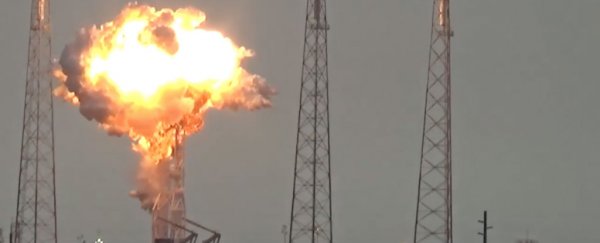Last month, SpaceX made headlines for all the wrong reasons, when its Falcon 9 rocket exploded at the Cape Canaveral Air Force Station in Florida.
Not only was this a major setback for SpaceX, which has been grounded ever since, but it also destroyed Facebook's first satellite - at a cost of US$195 million. Now investigators think they've finally figured out the source of the devastating explosion.
The investigation - which has been carried out by representatives from SpaceX, the US Federal Aviation Administration (FAA), NASA, the US Air Force, and other industry experts - has led them to the three helium pressure vessels that sit in the upper portion of the rocket.
These three vessels, called composite overwrapped pressure vessels (or COPVs), are part of the cryogenic helium system of the second stage liquid oxygen tank.
And investigators have now been able to replicate the problem in one of the vessels by simply tweaking the conditions inside the tank during the helium-loading process.
"Previously, we announced the investigation was focusing on a breach in the cryogenic helium system of the second stage liquid oxygen tank," SpaceX explains on its site.
"Through extensive testing in Texas, SpaceX has shown that it can re-create a COPV failure entirely through helium loading conditions. These conditions are mainly affected by the temperature and pressure of the helium being loaded."
Given that the explosion occurred during a routine tank filling, that means the engines weren't on, and SpaceX has been trying to identify an alternative heat source for the explosion ever since.
Now it looks like the flaw resulted from a slight change in temperature and pressure conditions inside the tank, which is actually far more disconcerting than if they'd found some faulty wiring, bad practice, or even sabotage that resulted in a rogue spark.
So SpaceX is left with two massive challenges: replicate the entire explosion event, to see exactly how shifting conditions can trigger an explosion; and redesign the cryogenic helium system, to ensure that it doesn't happen again.
Considering the timeline of the event is so incredibly short - from the first signs of a problem to a complete loss of data, it's 93 milliseconds, or less than one-tenth of a second - that's no easy task, even if you're looking in the right place.
"SpaceX's efforts are now focused on two areas - finding the exact root cause, and developing improved helium loading conditions that allow SpaceX to reliably load Falcon 9," the company announced over the weekend.
In case you somehow missed all the drama of the September 1 incident, SpaceX has experienced a lot of explosions over the past few years, but none have been quite so devastating as the one that resulted in the loss of a Falcon 9 rocket, and Facebook's first internet satellite.
While SpaceX has suspected the liquid oxygen tank this whole time, others couldn't help but concoct wild scenarios involving the company's competitor United Launch Alliance (ULA), which owns a building near where the explosion took place.
Earlier this month, unnamed industry officials reported that SpaceX saw an "odd shadow and then a white spot" on the roof of a nearby building just before the blast, which conspiracy theorists latched onto as the possible heat source they were looking for.
Of course, now we know we never even needed a heat source in the first place.
SpaceX will be continuing its investigations, but it says it's far enough along to be able to get back to business elsewhere:
"With the advanced state of the investigation, we also plan to resume stage testing in Texas in the coming days, while continuing to focus on completion of the investigation. This is an important milestone on the path to returning to flight."
Fingers crossed we see a return to flight by the end of the year, and hopefully SpaceX will learn things from this explosion that will help make all rockets of the future safer.
As Destin from Smarter Every Day points out in the video below, you can learn a whole lot more from failure than success:
